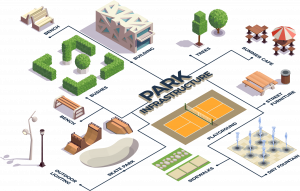Making Multicultural Parks
Japjot Singh
Overview
To create Multicultural inclusive parks, members of the community will need to be part of the planning and design of public parks. Martin and Boaz (2000) defines a spectrum of activities ranging from communication through consultation to co-production – the latter referring to the active and direct involvement of individuals or communities in policy debates, strategy formulation, and the design and delivery of local services. From the viewpoint of this present study, the concept of public participation through various participatory activities represents community involvement towards the higher end of this spectrum. The chosen methodology for this research is that of grounded theory (Glaser & Strauss, 1967, pp. 1–3). Grounded theory is an inductive method of generating new theory through the simultaneous collection, coding and analysis of data. The outcome of the research will be to form a design toolkit to inform others on the methods to make their park more inclusive.
To interact with the given image below, drag the slider (the red line with two arrows in the middle) left or right to see a standard park space on the left and the co-designed park on the right. Clicking the arrow button in the top right corner of the image will make them full screen so you can see them in a larger format. This image highlights the importance of including various communities and user groups during the design process.
Conceptualize & Prototype
During this phase the researcher would engage the participants in generating and sharing a broad range of ideas as individuals. The aim of the researcher will be to try out different participatory methods to get an unbiased response from a potential user of the public park.
 Given below are the participatory methods that will be part of the toolkit and some tools, if not all would be used in actual scenarios, according to the nature and engagement of the participants. This is done to keep the toolkit as flexible as possible by giving it the ability to adapt in different scenarios. While conducting the participatory session, the researcher will keep a track of which activity should be improved, modified or even removed from the process to have an inclusive toolkit which will achieve results.
Given below are the participatory methods that will be part of the toolkit and some tools, if not all would be used in actual scenarios, according to the nature and engagement of the participants. This is done to keep the toolkit as flexible as possible by giving it the ability to adapt in different scenarios. While conducting the participatory session, the researcher will keep a track of which activity should be improved, modified or even removed from the process to have an inclusive toolkit which will achieve results.
Once the prototype phase is over, the product will move towards its validation and evaluation stage. For this an evaluation matrix will be made which will act as a tool for evaluating public participation and results achieved (Speller & Ravenscroft, 2005b, p. 48). This would help the researcher to evaluate the process against a set of criteria by putting a structure in place that would keep the research in check.
Thank You
I hope you enjoyed this journey of creating Multicultural Public Parks by including various user groups. Thank you for exploring my exhibit. If you would like to share your feedback, please take a moment to complete the form below. Your participation is completely voluntary! Please note that your responses will help me to understand the effectiveness of my virtual exhibit and will not be used for any other purposes.
